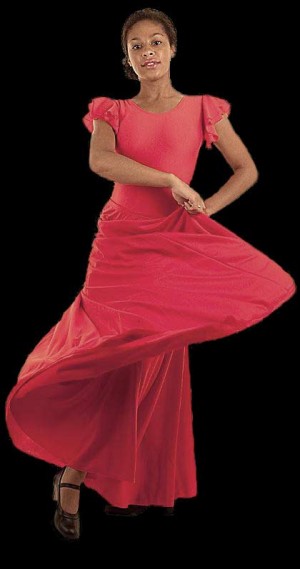The music, song and dance of Flamenco is said to have originated in Andalusia, in Southern Spain. It’s influenced by traditional music of Romani, with elements traced back to northern India, and even Greek, Moorish, and Jewish cultures. Influences can still be seen in the Indian Kathak dance.
The core of Flamenco dance is based upon  personal improvisation and spontaneous expression. It is renowned for its emotional intensity and proud presence; and can be easily recognized by an expressive use of the arms and rhythmic stamping of the feet.
personal improvisation and spontaneous expression. It is renowned for its emotional intensity and proud presence; and can be easily recognized by an expressive use of the arms and rhythmic stamping of the feet.
The role of the dancer is to interpret the words of the singer. It is made up of song (cante), guitar (toque), and hand clapping/dancing (baile), and although not from traditional dance, the castanets are often widely used in the dance. It involves a rhythmic collaboration of foot tapping, stomping, intricate guitars, and hand clapping with beautiful traditional song. Singers of Flamenco are known as cantaores, and are the most important element in the juerga (informal, spontaneous gathering similar to a jam session).
In the 18th Century the art of Flamenco dance was learnt from other performers, not in schools. But the guitarists went through rigorous professional training. Today, however, there are more Flamenco academies in Japan than Spain!
It was largely part of the Gypsy community but as this became less segregated it was possible for the community and the dance to be seen more publicly. Originally the Cante (song) was the core element of Flamenco, the guitar and dance came much later. It first became a public performing art in the second half of the 19th Century, when Cafés Cantantes became popular in Seville 1842, and was known as Opera Flamenca.
From the 1850s, it became a more professional dance. Performers used wooden platforms, but soon singing overtook the dance spectacle.
Flamenco occurs in four settings, in the juerga, in convert venues, in the theatre and in small-scale cabaret. The juerga and cabaret performances are informal settings, while the concert and theatre settings are formal. A traditional concert is very different to a juerga, as there is only one singer and one guitarist.
In theatres, Flamenco has become an extended dance in its own right comparable to ballet, and professional Flamenco companies such as Maria Pagés encourage and nurture professional Flamenco dancers.
In the mid 20th Century, Flamenco dance became popular again and was integrated into Ballets Flamencos, which were a mixture of traditional flamenco and new modern ideas. Concerts became less traditional, too, meaning that instead of just one guitarist and singer accompanying the dance, you’re more likely to find a Flamenco band consisting of three guitars, including a bass guitar, a piano, flutes or saxophones, and a cajon, a traditional wooden box drum played by hand (so without drumsticks). There are also more singers in this more modern setting, who often take turns to sing solos.
The main influencers on the evolution of Flamenco music include classical Andalusian Orchestras of the Islamic empire, Andalusian regional folk forms, Punjabi singing from India, Persian Zyriab singing, Jewish chants used in the Synagogue, African influences from slaves of New World Caribbean, as well as Central and South American colonies, Arabic Zayal, and Mozarabic forms such as Zambra and Zarchyas.
This variety of influences has also played an important role on the evolution of Flamenco dance styles, and modern influences and changes are shaping the way of Flamenco to this day.
The article was written by Move Dancewear, providers of dancewear for ballet, jazz, Flamenco and tap. Move are enthusiastic about dance, and aim to provide resources and inspiration to dancers of all dance varieties.